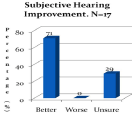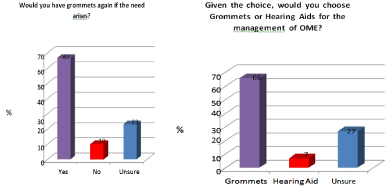
Research Article
Austin J Otolaryngol. 2016; 3(3): 1078.
Otitis Media with Effusion in Down’s Syndrome: Outcome Following Ventilation Tube Insertion
Rajagopal R*, Rizal FE, Prescott C and Hamid Daya
Oxford Deanery ENT Trainee, St George’s Hospital, London
*Corresponding author: Rajini Rajagopal, Oxford Deanery ENT Trainee, 111-113 Hampstead Rd, NW1 3EE, London
Received: July 19, 2016; Accepted: September 14, 2016; Published: September 16, 2016
Abstract
Objective: NICE guidelines recommend that hearing aids should normally be offered to children with Down’s syndrome and Otitis Media with Effusion (OME) with hearing loss. We looked at our experience in the light of the NICE guidelines and assessed parental satisfaction with grommet insertion.
Patients and Methods: We studied 75 children with Down syndrome referred to a tertiery ENT & audiology service centre for OME with hearing loss in 2005 & 2006, re-visited in 2011 & 2012. This was a retrospective case study review, outpatients and telephone questionairre.
Results: OME with hearing loss was diagnosed in 61 patients. 85% of these patients had grommets inserted. The average age of insertion was 5 yrs with a range of 1-11yrs. 47 patients had hearing aids fitted prior to insertion of grommets and 13 patients continued to use hearing aids due to a mixed hearing loss.
Conclusion: Our study has shown that parents prefer to undergo grommet insertion rather than have hearing aids. The technical difficulties with grommet insertion in children with Down’s syndrome were overcome by taking some specific steps during surgery and complications were less than anticipated.
Keywords: Down’s syndrome; Ventilation; Otitis media; Hearing aids
Introduction
In 1866, down described clinical characteristics of the syndrome that now bears his name. In 1959, Lejeune and Jacobs et al independently determined that trisomy 21 is the cause. Down Syndrome (DS) is by far the most common and best known chromosomal disorder in humans and the most common cause of intellectual disability [1].
The DS patient has clear anatomic differences in the head and neck region when compared with the general population. These anomalies include a flat occiput, oblique palpebral fissures, epicanthal folds, speckled irides, a protruding tongue, prominent malformed ears, and a flat nasal bridge.
Hearing impairment and otological problems including otitis media are still found in 38-90% of children with Down syndrome compared to 2.5% of normal children [1]. In DS, there is a clear increased incidence of congenital temporal bone anomalies, external auditory canal stenosis, mid-facial hypoplasia, poorly functioning Eustachian tube, comparatively small postnasal space, poor muscle tone, transmission rates that are accelerated at the brainstem or delayed at the cortex and a weak immunity [2]. All DS patients should undergo hearing assessment in the neonatal period, with follow-up as appropriate. Aggressive treatment of conductive hearing loss and early amplification may be necessary to maximize speech and language development [3].
Guidelines issued by NICE [3] recommend that DS children with Otitis Media with Effusion (OME) should be recommended hearing aid amplification and grommet insertion should be considered with caution after considering the several factors. This includes the child’s age, severity of hearing loss, practicality and heightened risks of surgery. Whilst these recommendations are correct there is concern that children with DS are being discouraged from undergoing grommet insertion. We wished to look at our experience in the light of the NICE guidelines and to assess parental satisfaction with grommet insertion.
Method
This was a retrospective case study review and telephone questionnaire. We completed it in two phases, one in 2005 to 2006 and the other 2011 to 2012. It included 75 children with Down’s syndrome referred to a tertiary ENT and audiology service centre for Otitis Media with Effusion (OME).
The review looked at indications for ventilation tubes insertion and associated sensorineural hearing loss. The use of hearing aids, surgical management of OME and the complications involved were closely assessed. We also looked at the number of repeated insertions and time to extrusion of the grommets. As part of a quality assessment and patient satisfaction survey, parents were also asked whether they were satisfied with the procedure and whether they would have it done again.
Results
Seventy-five children with Down’s syndrome were included in the study. OME with a conductive hearing loss was diagnosed in 61 (81%) patients. The mean conductive loss in those tested with pure tone audiometry was 50dB. 52 (85%) patients had ventilation tubes inserted (Table 1).
Number r
Percentage (%)
Diagnosis of OME in
DS
61
81
Grommets inserted
52
85
Table 1: OME with a conductive hearing loss and the mean conductive loss in those tested with pure tone audiometry.
The average age for grommet insertion was 5 years with a range between 1 – 11 years.
47 patients had hearing aids fitted as first-line treatment prior to consideration of grommet insertion for their glue-ear. Following regular three to four monthly follow-up, 38 of these patients went on to have ventilation-tube insertion. 14 patients had grommets inserted as first-line treatment. A total of 13 children continued to use hearing aids following grommet insertion primarily due to a mixed hearing loss picture (Table 2).
Number
Percentage (%)
Hearing aid use prior to
grommet insertion
38
62
Hearing aid use only
9
15
Grommet insertion only
14
23
Hearing aid use after
grommet insertion
13
25
Table 2: Grommet insertion due to a mixed hearing loss.
To identify if the patients benefited from the grommets, we assessed hearing improvement both subjectively and objectively. We asked parents whether or not they felt there was any improvement in their child’s level of hearing, and 71% felt that their child’s hearing was better and 29% were unsure if there was any difference, as they did not notice much change in their child’s behaviour or speech afterwards (Figure 1).

Figure 1: Submjective Hearing.
To see if there was any objective hearing improvement, we looked at the degree of hearing loss before and after the procedure using pure tone audiometry. Pre-operatively, 83.3% of patients had a moderate hearing loss between 40-60dB and 16.7% had severe hearing loss of more than 60dB. Post-operatively the majority of patients had improved to a normal (48%) or mild (23%) level of hearing loss, and only 29% were left with a moderate hearing loss. None of the patients hearing deteriorated after insertion of the grommets. In 6 patients hearing levels were unchanged (Figure 2).

Figure 2: Objective Hearing Improvement.
59% of the children who had grommets inserted had no complication. However, the main postoperative problem was recurrent otorrhoea. Recurrent infections occurred in (29.4%) and persistent otorrhoea was recorded in (11.8%). The average time to extrusion was 15.7 months with a range between 7 to 27 months.
Discussion
Otitis media with effusion is the most common cause of hearing loss in Down’s syndrome children [4]. In Glasgow, the prevalence of OME in Down’s syndrome was 93% at age 1, falling to 68% by age 5 [5-6]. OME can begin at birth and continue throughout the child’s life [1].
Children with DS who are found to have a hearing loss due to OME should be identified early and be provided with a means to either restore their hearing or to be fitted with hearing aids. The guidelines issued by NICE correctly recognize the practical difficulties with grommet insertion including surgical difficulty with insertion because of the narrow ear canals, increased risk of post grommet otorrhoea and early extrusion. However the fitting of hearing aids is not without its challenges in this group of patients in particular with the difficulties with narrow ear canals, wax impaction and associated feedback. The hearing loss associated with OME may also fluctuate which can cause difficulty with programming of the hearing aids. Repeated hospital attendance and compliance can also be an issue. Whilst the soft band system addresses some of these issues some patients find it uncomfortable to use and there can be difficulties with funding. In DS without an underlying sensorineural hearing loss, grommet insertion provides a definitive solution allowing restoration of hearing and reducing the number of their hospital appointments. Our study has shown that parents, if given the choice, would prefer to undergo grommet insertion rather than have hearing aids (Figure 3, 4).

Figure 3: Complications within 2 years.

Figure 4: Insertion of Grommets and Hearing aids.
The authors recognize the technical difficulties that can arise with insertion of grommets in those children with very narrow ear canals. To overcome this we use split aural speculums after applying adrenaline soaked cotton wool in the external auditory canal to maximise the exposure. We also choose titanium grommets which have a smaller height and allow manipulation within the ear canal compared to normal PTFE grommets. With these adaptations we have always been able to insert a grommet in DS children.
Post grommet otorrhoea is an issue in DS children, the reasons for which are not clearly understood but may reflect the increased risk of middle ear infections as a result of immune compromise. The NICE guidelines referred to a Japanese study which stated a 71% rate of otorrhoea in their patients with DS and 35.7% rate of otorrhoea in normal children. 41% of our cohort had post grommet otorrhoea comparable to the normal population group above.
Whilst early extrusion of grommets is reported in the literature, our results reflect a mean time to extrusion of 15.2 months, which is comparable to the normal mean time to extrusion.
NICE Guidelines recommend that the care of children with Down’s syndrome who are suspected of having OME should be undertaken by a multidisciplinary team with expertise in assessing and treating these children. Hearing aids should normally be offered to children with Down’s syndrome and OME with hearing loss. Before ventilation tubes are offered as an alternative to hearing aids for treating OME in children with Down’s syndrome, the following factors should be considered [4]:
- Severity of hearing loss
- Age of the child
- Practicality of ventilation tube insertion
- Risks associated with ventilation tube insertion
- Likelihood of early extrusion of ventilation tubes [4].
- Shott SR, Joseph A, Heithaus D. Hearing loss in children with Down syndrome. Int J Pediatr Otorhinolaryngol. 2001; 61: 199-205.
- Porter H, Tharpe AM. Hearing loss among persons with Down syndrome. Int Rev Res Mental Retardation. 2010; 39: 195-220.
- Kanamori G, Witter M, Brown J, Williams-Smith L. Otolaryngologic manifestations of Down syndrome. Otolaryngol Clin North Am. 2000; 33: 1285-1292.
- Sheehan PZ, Hans PS. UK and Ireland experience of bone anchored hearing aids (BAHA) in individuals with Down syndrome. National Institute for Health & Care Excellence (NICE). International journal of paediatric otorhinolaryngology. 2006; 70: 981-986.
- Balkany TJ, Mischke RE, Downs MP, Jafek BW. Ossicular abnormalities in Down’s syndrome. Otolaryngology: Head and Neck Surgery. 1979; 87: 372- 384.
- Barr E, Dungworth J, Hunter K, McFarlane M, Kubba H. The prevalence of ear, nose and throat disorders in preschool children with Down’s syndrome in Glasgow. Scott Med J. 2011; 56: 98-103.
The degree of hearing loss varies but even a mild degree can have major consequences on speech perception, language acquisition, development and academic achievement if not detected in time and corrected [5]. Early intervention to treat the hearing loss and adapted education is essential to facilitate the development of children with Down syndrome.
Although the numbers in our study are relatively small we believe there is still a place for ventilation tubes in DS children and this appears to be the majority preference of parents. We would recommend that this should still be a first line recommendation with appropriate informed consent so that parents are aware of the increased risk of post grommet otorrhoea and early extrusion.
Although the NICE guidelines in UK recommend hearing aids in the management of OME in children with Down’s syndrome prior to ventilation tube insertion, this study indicates that ventilation tubes have an important role to play and are preferred by parents.
References